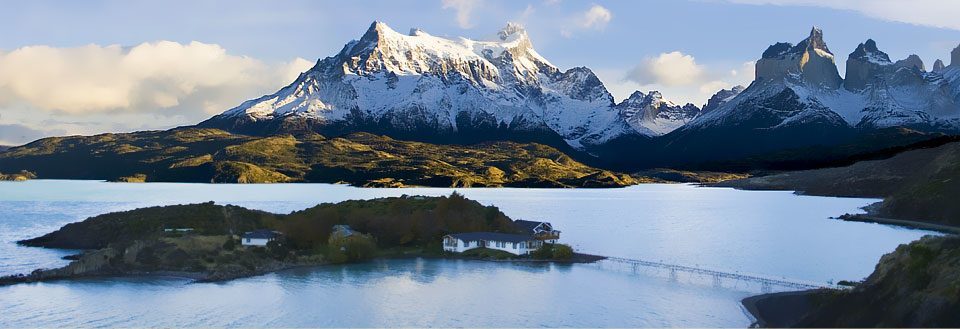Chile er et af de mest usædvanligt formede lande i verden. Det er 4200 km. langt og ikke over 180 km. bredt. Denne form betyder, at landet byder på alle slags klima og forskellige former for landskab. En formidabel kystlinie langs Stillehavet og Andesbjergene i hele den nordlige del af landet. Pga. den lange kystlinie er Chile et fortrinligt sted til forskellige former for vandsport.�
Republica de Chile
Santiago (5,000,000)
756,626 square kilometres
The principal language is Spanish.
Roman-Catholic
14,419,000 (1996)
Republic
Due to it's long shape almost all varieties of landscape are present in this country: The tall Andes mountains, volcanoes capped with snow, plenty of rivers and lakes, deep ravines, desert areas, ice fiords, glaciers and white sand beaches. The country ranges from the tropical north dominated by desert and volcanoes to the antarctic south with glaciers and ice mountains.�
Chile can be visited all year due to the varying geography. During summer the coastal regions are popular - whilst during winter the mountains surrounding Santiago attract many people interested in skiing. In the northern part of the country in the desert areas it can get very cold. It drops down to minus 20 degrees celsius at night, whilst day temperatures are around 25 degrees. �
Chile and Easter Island
South America on a shoestring
Central & South America
Peso (Ch$)
In case of emergency, please call one of the following numbers when visiting Chile:
Police (133)
Fire department (132)
Tipping is not included in prices in restaurants and hotels. Usually, an additional 10 per cent is added to the bill. Taxi drivers expect tipping, yet it is not required.
GMT - 6 hours (GMT -5 hours from second Sunday in October to second Saturday in March. (It is summer in Chile when it is winter in Northern Europe).
In Chile, the following units of measure are used:
Weight: Kilos
Distance: Metres
Capacity: Litres
�
Chile basically has no photography restrictions. However, do not take pictures of any military equipment or religious buildings.
Water in Chile should be boiled before drinking it or using it for tooth brushing or ice cubes.
Electric current operates on 220 volts AC, 50 cycles.
Chile has no special requirements.
Banks are open from 9 a.m. to 9 p.m. Monday through Friday.
Shops are open from 10.30 a.m. to 7.30 p.m. Monday through Friday, and from 9.30 a.m. to 1.30 p.m. on Saturdays.
Office hours are from 8.30 a.m. to 12.30. p.m. and from 2 p.m. to 6 p.m., Monday through Friday.
With its long coast Chile is renowned for a wide range of seafood, and the Chilean kitchen is reputed to be among the best in the world. As a visiting tourist it can be a good idea to make sure that your dinner is cooked thoroughly in order to avoid any stomach trouble. As regard to drink, Chile has many wine producers making excellent wines. Apart from wine - Pisco is very popular in Chile; a liqueur often mixed with Coke. It may be a little sour, but all in all it tastes like rum and Coke.�
Disabled travellers are not recommended to visit Chile: you will find no special facilities and they seem unused to assisting disabled travellers.�
New Year's Day, 1 January
Labour Day, 1 May
Navy Day, 21 May
St Peter and St Paul, 29 June
Assumption, 15 August
Day of National Unity, 6 September
Independence Day, 18 September
Army Day, 19 September
Columbus Day, 12 October
All Saints' Day, 1 November
Immaculate Conception, 8 December
Christmas Day, 25 December,
New Year's Day, 31 December
Reconciliation Day, the first Monday of September
Some camp-sites are present in Chile. The local tourist agencies can help you with detailed information. Most camp-sites are well equipped with rest-room facilities, hot-water showers, laundry, and perhaps even a small chemist.�
You will find more and more hotels in all parts of Chile. Hotels with between two and five stars can be found in almost all regions.�
Guesthouses can primarily be found in the Lake District area, and especially during summer, many families offer inexpensive rooms with kitchen and laundry facilities.
Youth hostels are primarily present in the large cities, and you will find good quality at a fair price. Youth hostels are increasingly popular in Chile, and so may also be found in some smaller cities.�
Several possibilities can be found in terms of domestic flying at a fair price. This enables you to reach larger cities in Chile, and due to the long distances, this may be a good way to travel.
Going by bus in Chile is an excellent means of transport as the bus network covers all larger cities. Buses are well maintained and very comfortable, prices are relatively low, and you are in for a very enjoyable ride. �
Trains run between the larger cities. Prices are low, especially in economy class, but the seats are in a very poor condition. Other seats are available which are more comfortable. The railroad network in Chile has been neglected during the last 20-30 years, so low quality and frequent delays should be expected.�
You will find taxis in all larger cities. You can easily get a hold of a taxi in the street, or you may call for one. You are advised to bargain for the price before accepting it.
You can rent cars in the larger cities. Please note that you cannot be sure to rent a car without a driver in some parts of the country.�
Ferries go between the mainland to many of the near-shore islands like Easter Island and Robinson Crusoe Island. Please note that ferries sail according to a very limited schedule and that you cannot always trust the arrival and departure times. Please confirm this with the local tourist agency. �
